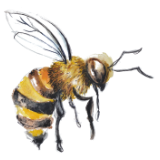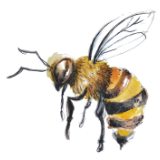How To Attract Bees To Your Garden
Attracting Bees to Your Garden: Simple Steps for a Buzzing Ecosystem
 Here are some tips to get you started:
Here are some tips to get you started:
Creating a bee-friendly garden is a rewarding way to support biodiversity and enjoy the beauty of these essential pollinators. Here are some simple and effective steps to get you started:
1. Plant Diversity is Key:
- Variety is essential: Incorporate a diverse range of flowers with varying shapes, sizes, colours, and blooming periods. This ensures a continuous nectar and pollen source throughout the growing season, from early spring to late summer.
- Consider bee preferences: While multi-petaled flowers may be visually appealing, they can be difficult for bees to access and may lack adequate pollen and nectar.
- Embrace your own preferences: If you have a favourite plant that isn't ideal for bees, don't worry! Focus on overall plant diversity, as other wildlife may benefit from it.

2. Embrace Native Plants and Wildflowers:
- Wildflower wonders: Plant wildflowers for a cost-effective and low-maintenance option. Simply clear an area, sow the seeds, and enjoy the natural re-seeding year after year.
- The power of trees and shrubs: Consider planting flowering trees and shrubs like apple, wild cherry, willow, and hazel, which provide abundant pollen and nectar.

3. Say No to Pesticides:
- Protect pollinators: Pesticides harm bees and other beneficial insects.
- Encourage natural pest control: A diverse garden attracts beneficial insects that naturally control pests.
- Dog & Cat flea treatments: Flea treatments are a pesticide, which could leave your animal when they go to the toilet. Reduce your reliance on these products and only use them when fleas are present.

4. Create Bee-Friendly Habitats:
- Build a bee house: Engage in a fun family project by building or purchasing bee and bug houses.
- Provide diverse habitats: Offer a variety of nesting sites and shelter for different bee species.

5. Rethink "Weeds":
- Dandelion delight: Embrace dandelions and other "weeds" like white and red clover, which are valuable food sources for bees.

By implementing these simple steps, you can transform your garden into a vibrant haven for bees and other pollinators.
Further Reading:

 Here are some tips to get you started:
Here are some tips to get you started: 




